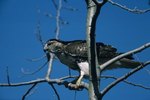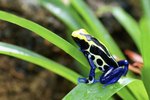
Beaks and tongues are instrumental in a bird's survival. Bird species that have a sharp beak have the ability to hold fish tightly, crack seeds and peck holes in trees to forage for food or build nests. Birds' tongues have bones in them and are not as flexible as a human's. Tube-shaped long tongues allow birds to retract liquid, like nectar. Long tongues with points at the end are used to catch insects.
Long-Tongued, Sharp-Beaked: Woodpeckers
Woodpeckers have strong sharp beaks that allow them to drill holes in unrotten solid wood and thick-barked trees. Woodpeckers' tongues are long and have a hyoid apparatus, which means the tongue has bone skeleton and cartilage. A sharp beak and long tongue provide the woodpecker with the ability to feed on insects that live under the bark of trees, thin-barked plants, weed stems and large grubs of wood-boring beetles.
Needle-Like: Hummingbirds
Hummingbirds -- with some 300 species worldwide -- use their long, sharp, needle-like beaks and tubular-shaped tongues to feed on the nectar of flowers, which in turn depend on hummingbirds for pollination. The nectar is at the base of the flower stem; the sharpness of the beak and length of the tongue determine what size flower the bird will feed on. Female hummingbirds use their long, tubular tongues and sharp beaks to feed their babies. Females release digested insects and nectar into the throats of their young by placing their beak deep down into the throat of a baby hummingbird and releasing the digested food.
Sickle-Shaped: Long-Billed Curlew
Long-billed curlews are shorebirds that have long, sickle-shaped beaks that allow them to forage for food in mudflats and grasslands, using their long bills to probe beneath the mud and sand within their habitat of salt marshes and tide flats. Long-billed curlews feed on caterpillars, beetles, spiders, grasshoppers and worms. The long, sharp beak is best suited for capturing crabs and shrimp living in deep burrows. Males have slightly shorter beaks than females.
Razor-Sharp: Great Blue Heron
Great blue herons have blade-like bills that are used to produce a sharp, fatal blow to their prey. Great blue herons are commonly seen near ponds, streams, marshes and coastlines. They use their razor-sharp beaks to catch prey by quickly thrusting them, delivering a death blow, and immediately consuming the prey in its entirety. Great blue heron feed on fish, insects, mice and other small animals located within their habitat.
References
- University of Michigan Museum of Zoology: Bird Bill Anatomy
- Yale Edu: Anatomy and Evolution of the Woodpecker's Tongue
- Fernbank Science Center: Bird Beaks
- Animal Planet: Hummingbird
- Planet of Birds: Long-Billed Curlew
- National Geographic: Great Blue Heron
- The Cornell Lab of Ornithology: Long-billed Curlew
Resources
Photo Credits
-
John Foxx/Stockbyte/Getty Images
Writer Bio
Based in Miami, Shellie Alyssa has been writing articles since 2011. Her articles have appeared on a variety of popular and informative pet websites including munch.zone. In 2000, she was awarded an editors choice award for Outstanding Achievement in Poetry from the International Library of Poetry. She holds a fashion merchandising diploma from Penn Foster College.




